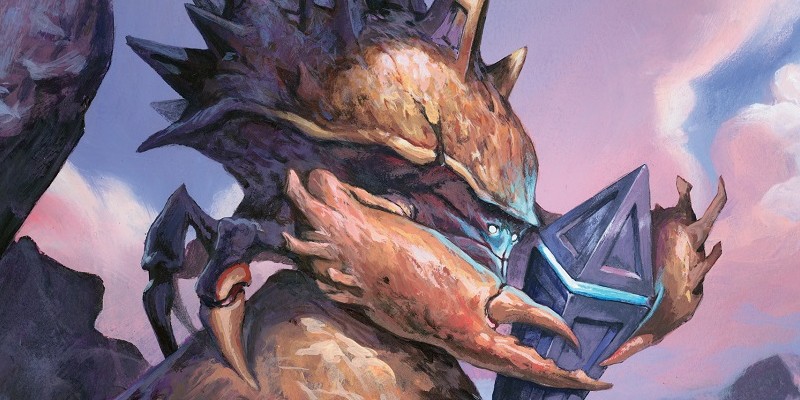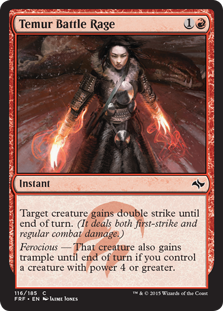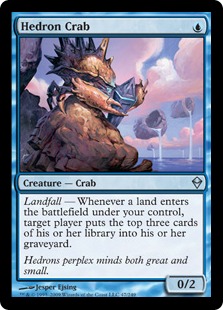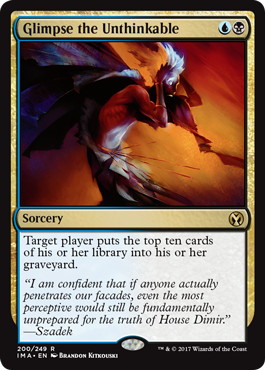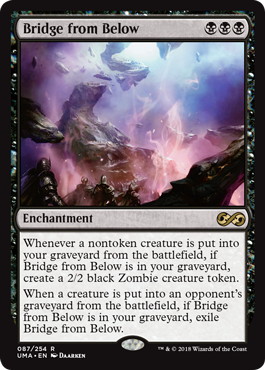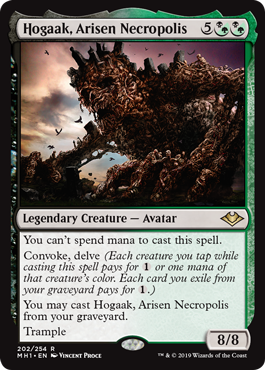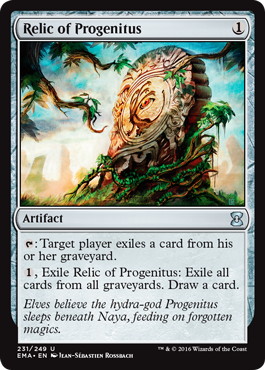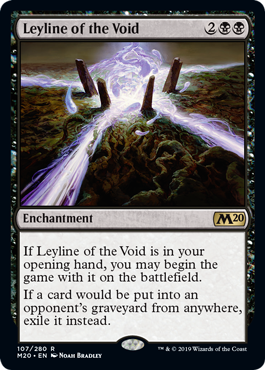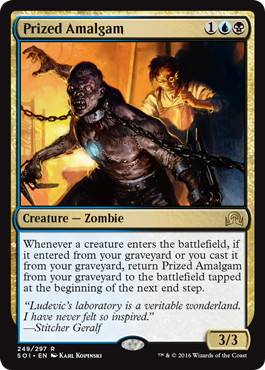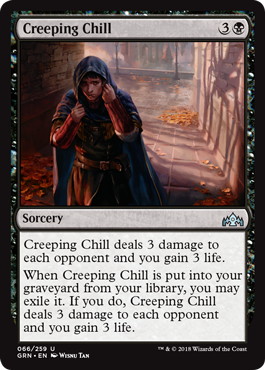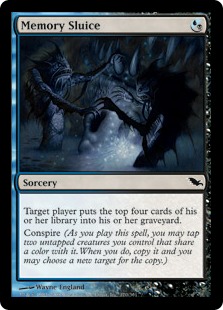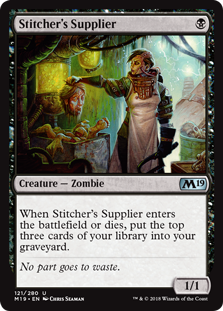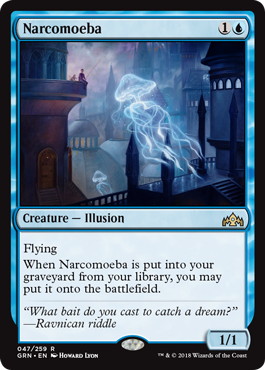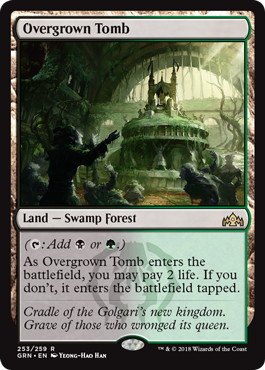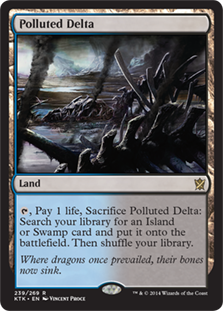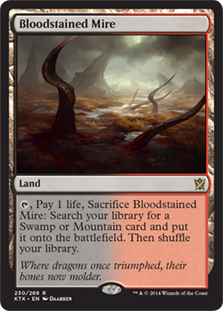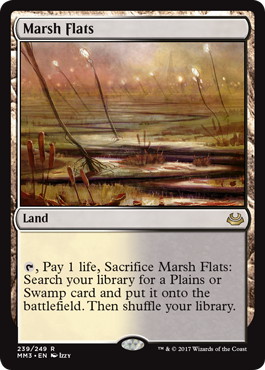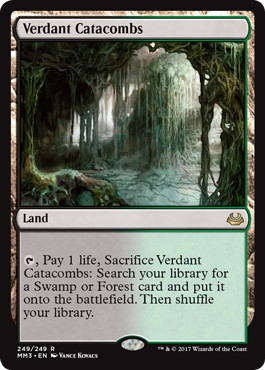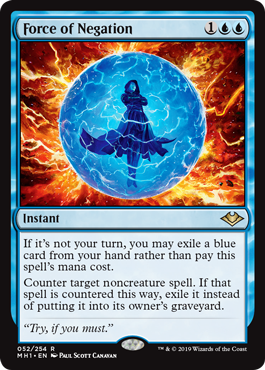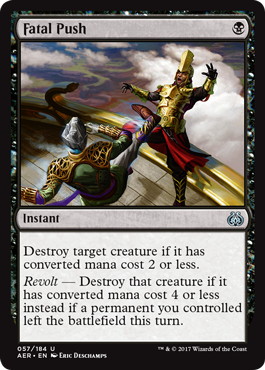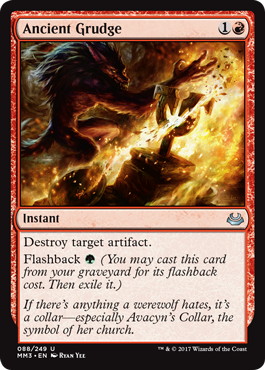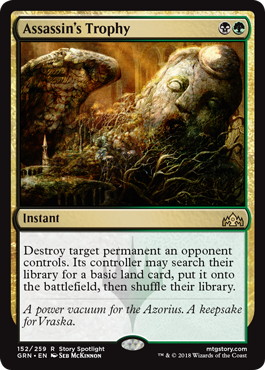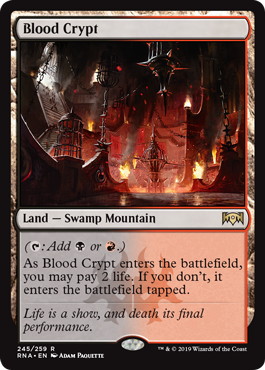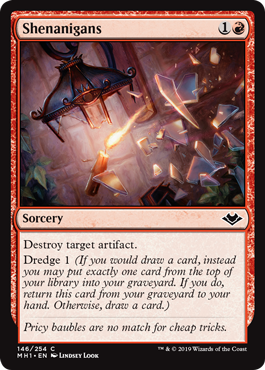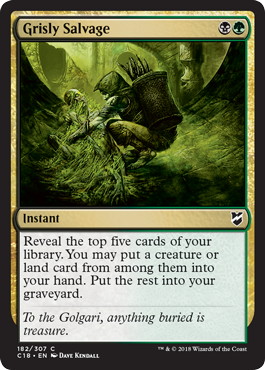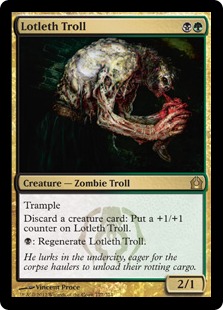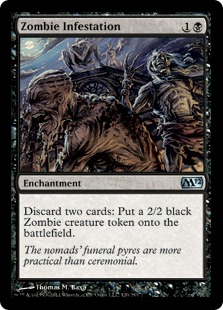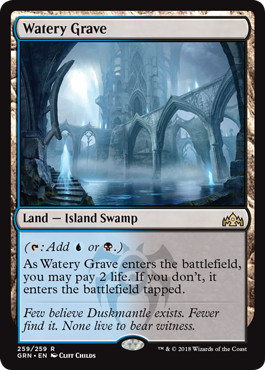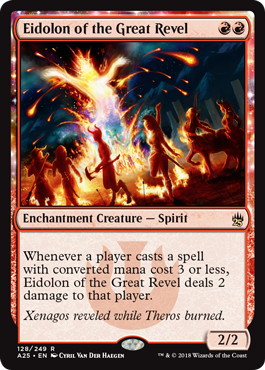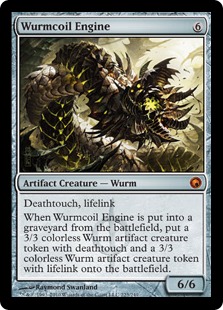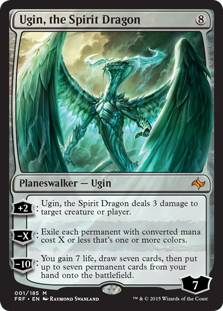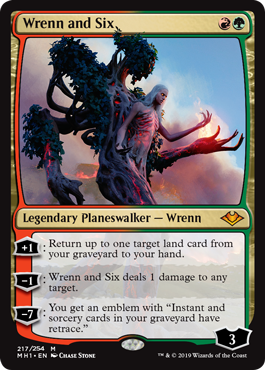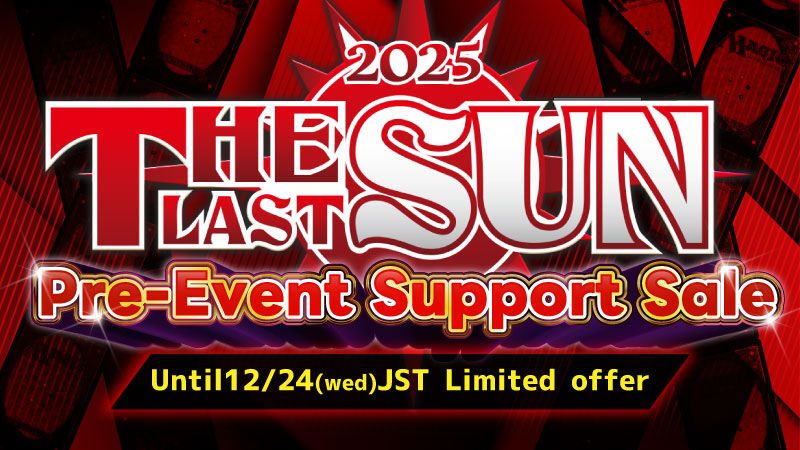Nogaak – No Problem
I didn’t really plan to write about the UB 《Vengevine》 version I built, but after having won the Modern PTQ at Magic Fest Utrecht, seeing more people pick up the deck and watching a few different streams, it became apparent that people needed a user manual in order to harness the full power of the deck, especially when it came to sequencing and sideboarding. In some cases it was as if you took a nicely polished Ferrari out for a joyride, you briefly appreciate the car glittering in the sun before taking off the rearview mirrors with a sledgehammer and then driving it backwards against a wall. 🙂
It’s easy to underestimate the deck’s complexity and I keep making mistakes and punting games away.
The Deck’s Evolution
I have played pretty much all versions of the deck, starting with Bridgevine including 《Greater Gargadon》 and 《Goblin Bushwhacker》 over a year ago, continuing with fully powered 《Hogaak, Arisen Necropolis》 featuring 《Bridge from Below》, followed by Jund Hogaak with 《Temur Battle Rage》 in Barcelona (not yet having grasped the power of 《Hedron Crab》 myself), then 4C Crab Hogaak in Birmingham, and briefly right before the banning the peak of perfection that was GlimpseGaak.
The Gaak incident forced Wizards to really bring down the hammer on the deck, which was a shame. I still find it baffling how the card came to be, they probably just rolled some dice to decide what numbers to print on the card and then Play Design was either intoxicated or already busy with balancing 《Oko, Thief of Crowns》.
Getting multiple cards from one of my favorite archetypes banned was unfortunate and it required some, let’s say, creative solutions to keep the deck competitive, all of which culminated in the latest version called Nogaak. After the bannings took place, I expected graveyard hate to disappear and decided to revisit the archetype during testing for Team GP Ghent, going through countless iterations of the deck before arriving at the build Elias Klocker and I submitted for the Team GP:
- Andreas Ganz
- – Nogaak
- Modern PTQ at Magic Fest Utrecht
- (Champion)
3 《Watery Grave》
2 《Overgrown Tomb》
4 《Polluted Delta》
3 《Bloodstained Mire》
3 《Marsh Flats》
3 《Verdant Catacombs》
-Land (20)- 4 《Hedron Crab》
4 《Carrion Feeder》
4 《Stitcher’s Supplier》
4 《Gravecrawler》
4 《Narcomoeba》
4 《Prized Amalgam》
4 《Vengevine》
-Creature (28)-
3 《Fatal Push》
2 《Ancient Grudge》
2 《Assassin’s Trophy》
2 《Leyline of the Void》
1 《Blood Crypt》
1 《Shenanigans》
-Sideboard (15)-
How the Deck Works
The goal is to either get 《Vengevine》s and 《Prized Amalgam》 into play on turn 2, using 《Hedron Crab》 and 《Stitcher’s Supplier》 to mill yourself, or set up on turn 2 with 《Glimpse the Unthinkable》 to really go off on turn 3 and deal the last few points of damage with 《Creeping Chill》.
This version is optimized to kill on turn 3, which against the goldfish happens somewhere around 20% of the time, or create a board on turn 2-3 that can’t really be dealt with. Turn 2 kills are theoretically possible but I’ve never been this lucky, and the deck goldfishes on average right around turn 4.
I think this is the most difficult to play version of the deck yet, followed by original Bridgevine. Hogaak was much easier to play while at the same time so powerful that it was quite forgiving when making mistakes. At first glance the game plan might seem straightforward, but the deck has a lot of unintuitive sequences and a tendency to punish even the smallest missteps. I recommend getting in as many reps as possible before taking it to an event and to continuously analyze your sequencing.
Card Choices
Mainboard
Enablers
《Hedron Crab》 and 《Glimpse the Unthinkable》 are your most powerful enablers and double 《Hedron Crab》 draws allow for really broken openings. Glimpse can be a two mana spell that deals 6 damage to your opponent, gains you 6 life and puts 4+ power into play on turn two.
However, there are some curves where drawing the first copy of 《Memory Sluice》 is much better than the second copy of 《Glimpse the Unthinkable》, allowing you to mill 8 more cards on turn three while still being able to trigger 《Vengevine》 and synergizing nicely with 《Narcomoeba》, making it the next best enabler in my opinion. Keep in mind that with a Conspired 《Memory Sluice》 you still get to mill four cards against a counterspell.
《Stitcher’s Supplier》 is your least powerful enabler in terms of how many cards you get to mill, but you do need to keep your zombie and creature count high enough to ensure the rest of your deck is functional.
Payoff
The payoff cards should be quite self-explanatory, 《Vengevine》 makes your fastest kills possible, while 《Creeping Chill》 is a nightmare for Burn to play against and 《Prized Amalgam》 plus 《Narcomoeba》 improve the potency of 《Glimpse the Unthinkable》 and act as a bridge to give you access to 《Gravecrawler》.
Supporting Cast
《Gravecrawler》 and 《Carrion Feeder》 get a category of their own as they aren’t true enablers nor payoff cards. 《Gravecrawler》 glues the two categories together, being a payoff card but at the same time an enabler for 《Prized Amalgam》 and 《Vengevine》.
《Carrion Feeder》 is sort of an enabler and plays lots of different subtle roles. After having extensively played with lists not running 《Carrion Feeder》, I think it makes the deck operate more smoothly overall and wouldn’t want to cut it. It keeps your zombie and one mana creature count high which is crucial, it helps trigger and especially retrigger 《Vengevine》s with 《Gravecrawler》, which can otherwise be difficult to accomplish. It has many additional matchup specific applications such as preventing lifelink from 《Wurmcoil Engine》, 《Batterskull》 and 《Daybreak Coronet》 and making sure your creatures go to the graveyard instead of being exiled by 《Ugin, the Spirit Dragon》, 《Deputy of Detention》, and 《Path to Exile》 or being bounced by 《Reflector Mage》.
In some games 《Carrion Feeder》 just grows to enormous size thanks to multiple copies of 《Prized Amalgam》 and a 《Gravecrawler》 and then goes to town.
Manabase
The manabase was quite contested and the reason for many arguments and discussions during testing. I did try other configurations incorporating 《Gemstone Mine》 and 《Darkslick Shores》, running fewer fetches, playing different fetchlands and 《Breeding Pool》 and once the red splash was added even a manabase with 《Steam Vents》 and 《Blood Crypt》 was considered.
Ultimately, while I think this manabase still has some issues, I believe it to be the best solution. Ideally all your lands would produce blue mana, but having a non-black producing land is just not acceptable as it will often mess up your curve. 《Swamp》 and 《Overgrown Tomb》 are by far your worst lands and I considered running only one 《Overgrown Tomb》 or even cutting them all together in case we decided to build a sideboard without green cards. I believe you want access to the second 《Swamp》 as it gives you better fetch patterns against aggressive decks such as Burn and to have additional insulation from 《Path to Exile》 and 《Field of Ruin》.
You want to maximize the power of 《Hedron Crab》, meaning every non-fetchland you add makes the deck slightly worse, at the same time I don’t want to go below 7 fetchable lands.
Playing 4 《Polluted Delta》 seems optimal against the Urza decks with 《Pithing Needle》, since it’s the fetchland they play four copies of.
Sideboard
One of the reasons to play this version of the deck is that you get access to 《Force of Negation》 out of the sideboard. During the early stages of deckbuilding the goal was always to keep the blue card count high enough to support Force as it’s a card that helps with combating some of your tougher matchups while also being decent against various hate cards.
You should consider updating the sideboard as it was built for the Team GP metagame. We were expecting Whirza to be among the most played decks and the red splash was mainly targeted at Whirza, where the combination 《Ancient Grudge》 and 《Shenanigans》 can let you win through 《Grafdigger’s Cage》 and 《Ensnaring Bridge》
Cards I’m Not Playing
Here is an incomplete list of cards that have either been (sometimes briefly) considered or tried in no particular order:
And many more. There was even a list running 《Rally the Peasants》, please don’t ask how it performed. 🙂
The card people most often ask about is 《Bloodghast》, and for good reason. In all the early versions of the deck I was running four copies of 《Bloodghast》, sometimes alongside 《Narcomoeba》, and it was a really difficult decision to finally cut them. One of the reasons being that the land count is not that high and the deck is built to function with only two lands if needed. You want to maximize your turn 2 explosiveness with 《Glimpse the Unthinkable》 finding 《Narcomoeba》 and 《Prized Amalgam》, allowing you to cast 《Gravecrawler》 on turn three from the graveyard even if you didn’t draw a zombie. Unfortunately, while still being a really powerful card, 《Bloodghast》 doesn’t enable these draws, as it is a slower and grindier card.
《Grisly Salvage》 is a solid enabler, albeit slightly less powerful than 《Glimpse the Unthinkable》, while at the same time putting more strain on your manabase and not being pitchable to 《Force of Negation》.
I don’t think adding discard outlets improves the deck, since they will give you more cards you don’t want to draw and you keep your hands based on already being functional and not on having outs to draw or mill a discard outlet. I try to avoid adding more cards that are close to bricks when drawn.
Tips and Tricks
As I’ve already mentioned, sequencing with the deck can be quite difficult and unintuitive, you want to make sure to take your time and think through your whole turn before starting to perform any game actions. Here are a few tips and tricks that should help you get the most out of the deck:
– Mulligan Discipline
You really need to be disciplined when it comes to mulligan decisions, one of the biggest mistakes people make when piloting the deck is to keep mediocre hands. Make sure to mulligan aggressively and don’t be afraid to go down to 5 or even 4 cards. In the PTQ I won 2 games on 4 cards in the semis and finals respectively.
Nogaak is one of the decks that abuses the london mulligan the most, as you get to shuffle your payoff cards back into your deck. Funnily enough, this means that your average 6 and 5 card hands are better than your average 7 card hands and the deck can still produce really explosive draws on 5 cards.
As a general rule of thumb, I mulligan most hands without two enablers unless there are some really special circumstances. Two 《Stitcher’s Supplier》 won’t count except if you also have a 《Carrion Feeder》 or know you are facing either a slower matchup or one where they are likely to die.
You very rarely want to keep one-landers unless you are already down to 5 or 4 cards, as hands with one land aren’t really functional.
– Slow Rolling One Drops
I frequently see people cast a one drop on the first turn without giving more thought to it, but it is often correct to save your one mana creature for turn 2 or even turn 3 if you are planning on casting Glimpse on turn 2. This means you will need to either draw only one more creature or mill a single 《Gravecrawler》 and will give you a better chance of triggering your 《Vengevine》s in situations where you didn’t already have three one mana creatures in hand.
In many spots you don’t want to expose 《Hedron Crab》 on the first turn to protect it from removal. This can again change depending on the texture of your hand (if you are holding 《Glimpse the Unthinkable》 or multiple Crabs) or when facing a deck with counterspells or discard.
In hands with 《Hedron Crab》 and 《Glimpse the Unthinkable》 you almost always want to play 《Hedron Crab》 on the first turn.
– Fetching Optimally with 《Hedron Crab》
Normally you don’t want to play a fetchland and respond to your 《Hedron Crab》 trigger by searching for a land. The best way to do it is to let the trigger resolve and if you hit a 《Narcomoeba》 you want to respond to the 《Narcomoeba》 trigger by fetching. This allows a 《Prized Amalgam》 that you might mill with the second trigger to see the 《Narcomoeba》 enter the battlefield.
All of this changes if you already have a guaranteed way of triggering 《Prized Amalgam》, such as 《Vengevine》 or 《Gravecrawler》, or if you are running low on fetchable lands, then it is correct to respond to the 《Hedron Crab》 trigger by fetching and avoiding the risk of running out of fetchable lands.
– Don’t Forget to Sacrifice Your 《Vengevine》s
Don’t forget to sacrifice your 《Vengevine》s to 《Carrion Feeder》 if you are going to cast a second creature, unless you are expecting a hate card such as 《Surgical Extraction》.
– Keep a Zombie Creature in Your Hand against Mass Removal
Make sure to keep a zombie in hand against decks with mass removal so that you can get back your 《Gravecrawler》 and 《Prized Amalgam》 after they sweep the board.
– Keep Track of Your Fetchable Lands
If you have already milled an 《Overgrown Tomb》 then there is no point in fetching for one unless you boarded in green cards or want to protect your 《Watery Grave》 and 《Swamp》 by leaving them in the deck.
– Don’t Fetch 《Overgrown Tomb》 Blindly
In some cases you want to have access to double blue mana on turn three to cast a 《Hedron Crab》 and a 《Narcomoeba》, which means you shouldn’t always automatically fetch for 《Overgrown Tomb》 once you have access to one 《Watery Grave》.
– Considering Your Clock and Matchup
If you have the option of bringing back a 《Vengevine》 on turn 2 or casting 《Glimpse the Unthinkable》 make sure to carefully consider your clock and the matchup to figure out what you would need the Glimpse to hit to make it better than just attacking with a 《Vengevine》 right away.
– Casting Your Creatures Wisely
It can often be correct to cast a creature / 《Gravecrawler》 from hand instead of from the graveyard to save it for a later point to trigger 《Prized Amalgam》.
– Learning The Amalgam Tricks
The Amalgam trick lets you get back 《Prized Amalgam》 at the end of your opponent’s turn and grow your 《Carrion Feeder》 for free. When you control a 《Carrion Feeder》 and have multiple copies of 《Prized Amalgam》 trigger at the end of your turn you want to let them enter one by one and always sacrifice them right away so that they see the last 《Prized Amalgam》 enter play. This will give you Amalgam triggers in your opponent’s end step, allowing you to play around mass removal such as 《Anger of the Gods》 or 《Supreme Verdict》. Depending on the board state you can keep going and sacrifice the Amalgams again in your opponent’s end step to grow 《Carrion Feeder》.
Keep or Mulligan and Sequencing
Keep or Mulligan
To put the theory into practice here are a few example hands and my take on them:
Sample Hand 1
I would mulligan this hand as you are really reliant on 《Stitcher’s Supplier》 finding a 《Narcomoeba》 or 《Gravecrawler》 to be able to mill enough cards, and I think you can do much better on six cards. If this hand had an additional one mana creature I would keep.
Sample Hand 2
While not optimal, I think you should keep this hand and try to build a board on turn 3, but I wouldn’t really fault anyone for taking a mulligan, especially on the draw.
Sample Hand 3
This hand is as close as it gets, you don’t have any bricks in hand but also only one enabler. I would mulligan this hand on 7 cards and keep on 6 cards. 《Carrion Feeder》 will allow you to trigger 《Vengevine》 on turn 3 even if you have to run out your creatures to Conspire 《Memory Sluice》.
Sample Hand 4
While similar to one of the previous hands, I think this hand is a mulligan, as it is lacking a second one mana creature or a second enabler.
Sequencing
Here are a few example hands and board states to practice sequencing:
Sample Hand 5
I would lead with a tapped 《Watery Grave》, fetch for 《Swamp》 on turn two to cast Glimpse and then hopefully bring back 《Vengevine》 on turn three.
Sample Hand 6
Again you shouldn’t play 《Gravecrawler》 on turn one. Play a tapped 《Watery Grave》, followed by 《Swamp》 on turn two in case you draw a 《Hedron Crab》 and then 《Glimpse the Unthinkable》. On turn three you will have to decide on the best play based on what was milled with the first Glimpse.
Sample Hand 7
This hand is a little more intricate, but again I wouldn’t play 《Stitcher’s Supplier》 on the first turn. The upside of running it right away is that you can potentially get access to any 《Vengevine》 milled on turn 3 with a Conspired 《Memory Sluice》 if you either draw a one drop and mill a 《Gravecrawler》, draw two one drops or mill two 《Gravecrawler》.
The best case is to find a 《Narcomoeba》 to help Conspire 《Memory Sluice》 and then follow that up with 《Gravecrawler》.
The risk is bricking completely by not drawing one mana creatures or milling 《Gravecrawler》, or your opponent removing 《Stitcher’s Supplier》 right away. If they have instant speed removal for your turn three to kill 《Stitcher’s Supplier》 with the trigger on the stack then you still had outs to mill 《Narcomoeba》 and 《Prized Amalgam》 with Glimpse on turn two or draw a second one mana creature to trigger 《Vengevine》.
If the 《Stitcher’s Supplier》 was a 《Carrion Feeder》 that would make the decision closer as it would allow you to get 《Vengevine》 triggers on turn three with only one 《Gravecrawler》, but I still wouldn’t play it on the first turn.
Sample Hand 8
How do you play your second turn?
There is a chance you will be able to present lethal damage on turn three by just getting back 《Vengevine》 this turn. I would fetch for a 《Swamp》, play 《Carrion Feeder》 and sacrifice 《Stitcher’s Supplier》 to give you a shot at finding a second 《Vengevine》 or 《Prized Amalgam》 and follow that up with 《Gravecrawler》. A second 《Vengevine》 or 《Prized Amalgam》 in combination with hitting a 《Creeping Chill》 with Glimpse or just two 《Creeping Chill》 can give you lethal damage.
Matchups & Sideboarding
You often want to sideboard lightly to keep the deck as functional as possible, only trimming a few cards, and then adjust based on what you see from your opponent. Once you know you are up against cards such as 《Rest in Peace》, 《Leyline of the Void》, you want to board more 《Force of Negation》 and/or 《Assassin’s Trophy》.
Rw Burn
This is one of your best matchups, it’s really difficult for Burn to beat a deck that builds a board presence this quickly and follows it up with 《Creeping Chill》, Burn being quite popular at the moment is one of the reasons to pick up Nogaak.
《Overgrown Tomb》 is by far your worst land, as you want to just fetch for 《Watery Grave》 and 2 《Swamp》s and never want to get into a position where you can/have to cast 《Vengevine》.

Against Rw Burn
Post-board when holding 《Fatal Push》 you often don’t want to kill their 《Goblin Guide》 or 《Monastery Swiftspear》 right away, even if that means taking more damage, but instead wait to see if they have 《Eidolon of the Great Revel》 on turn 2, since that card can be much more devastating.
In the dark I normally don’t bring in 《Force of Negation》, or just one copy, unless you have a read on your opponent or have already seen 《Rest in Peace》. In a paper event you want to pay close attention to how they sideboard. At the team GP my opponent told me that this was his first GP, when it came to sideboarding he quickly grabbed a few cards, put them in the deck and then conferred for quite some time with his teammate about some other cards still left in the sideboard.
This gave me the impression he had cards in the sideboard that were so obviously powerful in the matchup that it was easy for him to identify them and I assumed these cards to be 《Rest in Peace》, boarding in all 4 《Force of Negation》 and countering my opponent’s turn 2 《Rest in Peace》.
This also serves as a reminder to not make your sideboarding too obvious, for example disguising it by just adding all 15 cards to your deck first.
If you do see 《Rest in Peace》 you will want to board in all 4 《Force of Negation》 on the draw and 2 to 3 copies on the play.
Tron

Against Tron (On the Play)

Against Tron (On the Draw)
This is one of the matchups where 《Carrion Feeder》 shines, as 《Wurmcoil Engine》 is one of their best cards against you and it prevents the exile effect from 《Ugin, the Spirit Dragon》. I am unsure about boarding out one copy of 《Carrion Feeder》, so feel free to experiment with taking out another payoff card or only bringing in 2 《Force of Negation》 or 1 《Ancient Grudge》 on the draw.
《Ancient Grudge》 helps combat a fast 《Wurmcoil Engine》 and can sometimes hit 《Expedition Map》 when on the play or force a 《Relic of Progenitus》 activation. 《Force of Negation》 can be used to prevent them from finding Tron or combating hate such as 《Grafdigger’s Cage》 or 《Relic of Progenitus》. The more mulligans your Tron opponent took, the more aggressively I would want to use 《Force of Negation》.
Jund

Against Jund
Try not to expose 《Carrion Feeder》 to a potential 《Wrenn and Six》 and save your 《Fatal Push》 for 《Scavenging Ooze》 and 《Plague Engineer》 in case 《Tarmogoyf》 is not too big of a threat or roadblock. If they have 《Leyline of the Void》, which I wouldn’t expect, you need to bring in 《Assassin’s Trophy》.
Whirza

Against Whirza
This is the version of Urza for which the sideboard was built originally. You want to make sure that they are playing 《Goblin Engineer》 when sideboarding like this. It is really difficult for them to accomplish anything if you have a Leyline in play. 《Ancient Grudge》 is the best option at preventing them from stalling the game with 《Ensnaring Bridge》 and 《Shenanigans》 is your out to 《Grafdigger’s Cage》.
Urza Ascendancy Paradoxical Outcome

Against Urza Ascendancy Paradoxical Outcome
I haven’t tested this matchup too thoroughly since the deck didn’t exist at the time of the Team GP, I believe it to be slightly unfavorable but 《Force of Negation》 should pull its weight post board, countering 《Jeskai Ascendancy》, 《Paradoxical Outcome》 and 《Saheeli, Sublime Artificer》.
Titanshift

Against Titanshift
Try to play around 《Anger of the Gods》 if you can afford to or have 《Force of Negation》 ready.
Eldrazi Tron

Against Eldrazi Tron (On the Play)

Against Eldrazi Tron (On the Draw)
I think on the play you can afford to have a card like 《Assassin’s Trophy》 that answers their hate while also dealing with their creatures, on the draw it seems better to have 《Force of Negation》 answering cards like 《Chalice of the Void》, 《Grafdigger’s Cage》, 《Relic of Progenitus》 and 《Karn, the Great Creator》 without losing too much tempo.
UW Control

Against UW Control (On the Play)

Against UW Control (On the Draw)
On the draw it is more likely that you will be forced to answer 《Rest in Peace》, while on the play you can often create a board presence that is difficult for them to deal with.
Decking your UW opponent when 《Rest in Peace》 has resolved can happen occasionally, so keep that gameplan in mind.
UW Stoneblade

Against UW Stoneblade (On the Play)

Against UW Stoneblade (On the Draw)
An easy way for UW Stoneblade to steal a game is to have a quick 《Batterskull》, which is why I like bringing in both 《Ancient Grudge》 on the draw. If you are on the draw and know they have 《Rest in Peace》, consider bringing in more 《Force of Negation》.
Humans

Against Humans (On the Play)

Against Humans (On the Draw)
The idea is that you don’t want to draw multiple 《Glimpse the Unthinkable》 against a 《Thalia, Guardian of Thraben》 deck, but I’m still not sure if it is correct to cut one of your best enablers. From the Humans side it can often be correct to name 《Gravecrawler》 with 《Meddling Mage》.
Dredge

Against Dredge
I think you are a slight favorite in this matchup as you have a faster goldfish kill. 《Force of Negation》 can hit a 《Cathartic Reunion》 to slow Dredge down.
A question I often see is if this deck is better than Dredge. First of all, it is quite a different deck, and yes, I do believe it is overall a better deck, offering a faster goldfish kill and more resilience to hate, often allowing you to build up a board presence much quicker and in desperate times giving you the option to just cast your creatures to beatdown. You also get to play an improved sideboard thanks to having access to 《Force of Negation》. Dredge needs to draw the right mix of enablers and dredgers and find more dredgers, while Nogaak just needs to draw enough enablers.
I can see Dredge be a better deck in really specific metagames where 《Conflagrate》 and 《Life from the Loam》 are well positioned, Dredge is better at playing a longer, grindier game if that’s what is needed.
Druid Combo

Against Druid Combo
This is one of your tougher matchups, Druid Combo can be faster than you while putting blockers in the way with 《Giver of Runes》.
Amulet Titan

Against Amulet Titan (On the Play)

Against Amulet Titan (On the Draw)
《Force of Negation》 allows you to slow them down by countering 《Amulet of Vigor》 or 《Summoner’s Pact》.
Neobrand

Against Neobrand
This is one of your worst matchups despite having access to a playset of 《Force of Negation》. Neobrand is so much faster, that there is immense pressure on your opening hand having 《Force of Negation》 and being functional. If you keep 《Force of Negation》 but too slow of a hand they can protect their combo with 《Veil of Summer》.
You want to prioritize dealing as much early damage as possible, as this can prevent them from finding 《Nourishing Shoal》 with 《Griselbrand》.
Spirits

Against Spirits
Again, if you see 《Rest in Peace》 make sure to bring in 《Force of Negation》 on the draw.
Hardened Scales

Against Hardened Scales
Infect

Against Infect
The idea is to take on a control role while building up a board. 《Narcomoeba》 is a great blocker against Infect, you just want to prevent them from killing you with 《Blighted Agent》 or 《Distortion Strike》.
Affinity

Against Affinity
Bogles

Against Bogles
Ad Nauseam

Against Ad Nauseam
They are able to buy a lot of time, making this a difficult matchup. Your main focus should be on countering or destroying 《Phyrexian Unlife》.
Grixis / Jund 《Death’s Shadow》

Against Grixis / Jund 《Death’s Shadow》
I like keeping in all copies of 《Creeping Chill》, as they often get into spots where they are forced to put themselves on a low life total. Try to maneuver around 《Plague Engineer》 and if you see 《Leyline of the Void》 make sure to bring in 《Assassin’s Trophy》.
Ponza

Against Ponza
Be aware of 《Blood Moon》 and get your 《Swamp》s into play so that you are still somewhat functional if you don’t have 《Force of Negation》 for it.
Updating the Deck
There are multiple Throne of Eldraine cards that are potential additions to the deck. The cards in question are 《Merfolk Secretkeeper》, 《Once Upon a Time》 and 《Oko, Thief of Crowns》. I didn’t have time to properly test the new cards and only theorized about them. I don’t think any of these cards are better than the cards currently in the maindeck.
What people tend to underestimate is that Secretkeeper can be slightly awkward for your mana in some sequences. I could see running a split of 3 《Carrion Feeder》 / 1 《Merfolk Secretkeeper》, but I still believe that the fourth 《Carrion Feeder》 adds to the consistency of the deck and makes it operate smoothly. 《Memory Sluice》 being easier to cast and milling 8 cards outweighs the benefit of having a creature stapled onto a spell that mills only 4 cards.
《Once Upon a Time》 gives you more cards that you don’t want to draw on a later turn and puts slightly more strain on your mana. Besides 《Hedron Crab》 there aren’t that many high impact creatures you want to find, and I don’t think the downsides justify the upside of being able to have a split card of land / one mana creature in your opening hand. If there was a second creature enabler as good as 《Hedron Crab》 that might change my view on 《Once Upon a Time》, though I can see being wrong on the card and it’s entirely possible it should have a place in the deck.
《Oko, Thief of Crowns》 is the most promising card of the bunch. I’m not convinced it is really needed or worth the slots, as it is a card that doesn’t support your primary gameplan and most of the time only becomes relevant once your development has been stifled / you are facing hate. I think the matchups where Oko shines are already favorable, such as UW Control. It might be at its best against something like Eldrazi Tron with 《Grafdigger’s Cage》.
Other potential changes are adding more graveyard hate to the sideboard, if you anticipate to play mirror matches and as a consequence upping the number of answers to 《Leyline of the Void》, removing the red splash if you expect Urza Ascendancy PO to take the place of Whirza, as the red sideboard was specifically built to combat the 《Whir of Invention》 deck.
When trying new maindeck cards, especially for an archetype such as Nogaak, I recommend goldfishing as many hands as possible to get a feel for these cards instead of playing random games on Magic Online, you will get a bigger sample size and a much better understanding for how a card performs and how certain play sequences change. Once you have decided on a new configuration to test, I would always play matches against the specific matchups you deem most important and approach these matchups with a list of questions you want to try and answer. Only when you are close to finalizing your list does it really make sense to practice on Magic Online, as you move from testing your deck to just getting in a few more reps, and these aren’t the same things in my opinion.
Conclusion
I don’t think the deck is broken by any means, but it has been well positioned for quite some time, with graveyard hate declining and favorable matchups occupying a substantial share of the meta, the deck might be in a slightly worse spot now, if people dedicate more hate to it, but it is still an inherently powerful deck.
Thank you for reading and let me know if you have any questions.
Andreas Ganz (Twitter)


